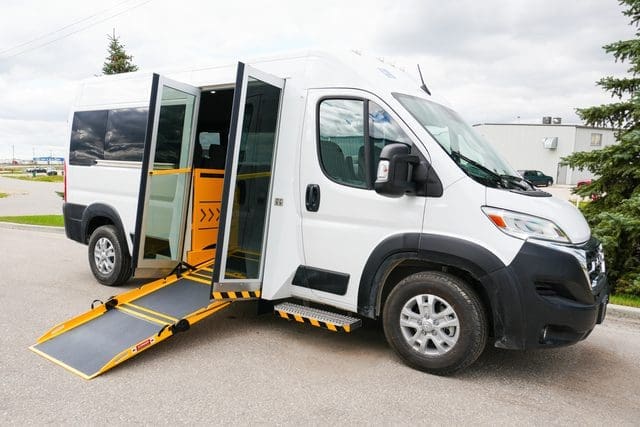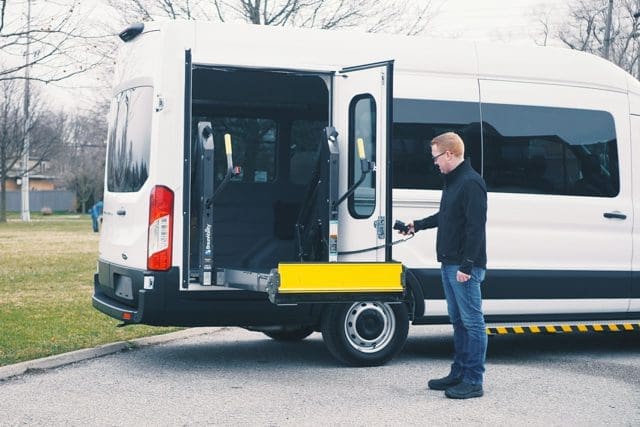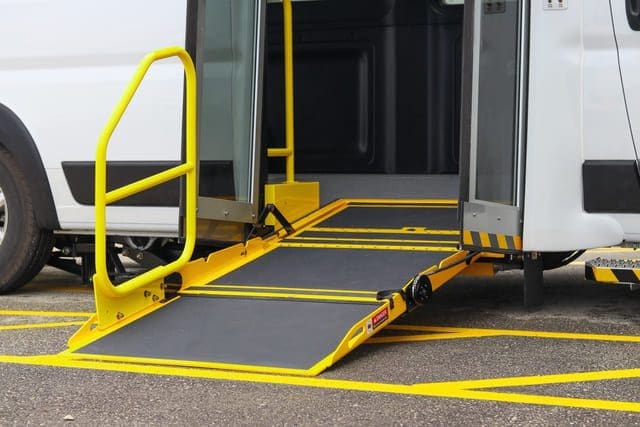Did you know that 1 in 6 people in Canada live with a sensory disability? That includes people with autism, brain injuries, PTSD, or anxiety.
But here’s the problem: Most places just aren’t built for people who struggle with noise, lights, or crowds. You might be feeling stuck. You want to help more people, but your current vehicle space is too busy, too loud, or not calming enough. It’s hard to offer support when the environment itself gets in the way.
When there’s no quiet space for people to reset, they may:
- Feel overwhelmed or anxious
- Avoid your program altogether
- Miss out on the help they need
That’s the gap. And it’s a big one.
A mobile sensory station can help fill that gap. It provides a quiet, calming space that travels with you wherever your services go.
At MoveMobility, we build mobile medical units that remove barriers to healthcare. We’ve worked with organizations across Canada for over 20 years. Our team is Ford QVM and Stellantis QPro certified. And while we manufacture mobile medical units, this article isn’t about selling. It’s about answering your questions and helping you learn what’s possible.
In this article, you’ll learn what a mobile sensory station is, how it works, and if it’s the right fit for your organization.
What a mobile sensory station is (and what it’s not)
A mobile sensory station is a vehicle designed to be a calm, quiet space for people who get overwhelmed by noise, lights, or crowds. Think of it like a room on wheels that helps people feel safe and comfortable, especially during stressful situations.
It’s not a classroom or treatment space, and it’s not a van full of flashing lights and sounds (that would be the opposite of helpful).
Instead, it’s made to give people a break from the chaos. You might see mobile sensory stations at:
- Community events
- Schools or daycares
- Homeless outreach programs
- Vaccination clinics
- Emergency response sites
Some people call it a mobile sensory unit, but that means the same thing. You might also hear the term mobile sensory room, and it’s all about the setting. “Station” just makes it sound more official.
A mobile sensory station gives your team a safe, comfortable space to support people who need a moment to breathe.
How does a mobile sensory station work?
Using a mobile sensory station is simple, and that’s the point. It’s made for people who are already feeling overwhelmed. The last thing they need is more confusion.
Here’s how it works: When someone starts to feel overstimulated, maybe from bright lights, loud noises, or too many people, they can step into the mobile sensory station. Once inside, the environment is calm, quiet, and designed to help them relax.
It’s a reset zone. No pressure. No expectations. Just space to breathe.
Here’s what happens inside:
- The lights are soft: No flickering, buzzing, or harsh bulbs
- It’s quiet: Sound-dampening walls help block out outside noise
- It feels cozy: Think soft chairs, calming colours, and maybe a weighted blanket
- There are sensory tools: Items like fidget toys, textured panels, or gentle music help regulate emotions
The vehicle is designed so your staff or team can stay close by if needed, but give people space when they want it.
The best part? The mobile sensory unit goes where your team goes. It travels with your programs and services, making it easier to reach folks in schools, on the street, or at busy public events.
It’s a portable pause button. For people who sometimes feel like the world is too much, that small break can make a big difference.
Who can mobile sensory stations help?
Sensory processing issues affect more people than you might think.
Let’s start with autism. According to the Public Health Agency of Canada, about 1 in 50 children is diagnosed with autism spectrum disorder (ASD), and many adults live with it, too.
For people with autism, even everyday places like school hallways, waiting rooms, or busy events can be overwhelming. Bright lights, loud sounds, strong smells… it can all hit at once and trigger sensory overload.
Mobile sensory stations help by offering:
- A quiet space to calm down
- Tools to help with self-regulation
- A break from busy or stressful environments
But it’s not just people with autism who benefit. These stations also support:
- People with ADHD or anxiety
- Children and adults with PTSD or brain injuries
- Anyone who experiences sensory sensitivities
Here’s the thing: Sensory overload doesn’t always come with a warning. It can happen fast, and it’s different for everyone. When there’s no safe place to go, some people shut down. Others act out. And some just leave without getting the care or support they came for.
A mobile sensory unit helps prevent that. It shows people they’re seen, they’re safe, and they don’t have to leave to feel okay again.
Why would organizations choose mobile sensory stations over fixed sensory stations?
You might wonder, why go mobile at all? Can’t you just build a sensory room in your building and call it a day?
Sure, fixed sensory rooms can be great. But they only work if the people who need them can access them, and that’s the real gap.
A mobile sensory unit gives you the freedom to go where your people are, not the other way around.
Here’s why mobile makes more sense for many organizations:
You serve more than one location: If your team travels or supports different schools, communities, or neighborhoods, a fixed room just doesn’t cut it.
Outreach work: If you do outreach work, you can bring the calming space with you to public events, mobile clinics, or pop-up programs.
Your space is limited: Not every building has extra rooms or money to renovate. A mobile sensory unit skips the need for construction.
You support rural or remote areas: Many communities are spread out across Canada. A mobile station helps you reach those places without needing a permanent setup.
Think of it this way: A fixed sensory room stays put. A mobile sensory station moves with your mission.
It’s a flexible, cost-effective way to extend your reach and make sure nobody’s left out, especially those who need sensory support the most.
Let’s talk about how to customize your mobile sensory station to fit the needs of your organization and community.
Where are mobile sensory stations needed most in Canada?
Some areas in Canada have higher rates of sensory-related challenges than others. And if you’re based in one of those regions, a mobile sensory station might be more than helpful, it might be essential.
Let’s look at the numbers.
According to the Public Health Agency of Canada, Newfoundland and Labrador has the highest rate of autism diagnoses in the country, with 1 in 40 children identified as being on the autism spectrum.
Other provinces like Ontario and Nova Scotia also report high numbers, especially in urban centers. But even in lower-population provinces and territories, the need is still there, especially in remote or rural communities where support services are limited or hard to access.
Here’s where mobile sensory units make the biggest difference:
- Rural or remote towns with no fixed sensory rooms or support centers
- Urban areas where school systems or events see frequent sensory overload
- Provinces with higher neurodiverse populations (like NL, NS, and ON)
- Regions with growing newcomer populations who may have undiagnosed sensory needs
The truth is, many communities across Canada just don’t have enough safe, calming spaces. When there’s a gap like that, mobile sensory stations help close it. There’s no renovation and no extra building. You just drive up and support the people who need it.
Do you have any questions about mobile sensory units?
You came to this article because you’re facing a challenge. You’ve likely recognized people in your community are struggling with sensory overload, and right now, they’re not getting the help they need. Maybe you’ve seen people who can’t make it into fixed sensory rooms because of transportation or logistical barriers.
Here’s what you learned:
- What a mobile sensory station is, and why it’s different from a typical sensory room
- How it works as a calm, mobile reset space
- Who it helps, like individuals with autism, PTSD, anxiety, or brain injuries
- Where it’s needed most in Canada, based on real stats and gaps in care
- Why mobile matters, especially for outreach programs and remote communities
At MoveMobility, we’re proud to support changemakers like you, people who show up for others, even when it’s hard. We’ve spent over two decades designing vehicles that remove barriers and help communities thrive. Our team is all about building trust, solutions, and relationships. When you work with us, you’re not getting a product. You’re getting a partner who gets it.
If you have questions or want to see what this could look like for your team, click the button below to talk to a mobility expert. We’re here to help.
And if you’re not ready to talk to a mobility expert yet, we’ve got some great resources you can check out to learn more.
Start by learning a little more about how to apply for funding for mobile medical units. The video below on how to write a grant application can also help with that.
After that, check out the article on the five steps to buying a mobile medical vehicle. This can give you some more direction on what to do next.







